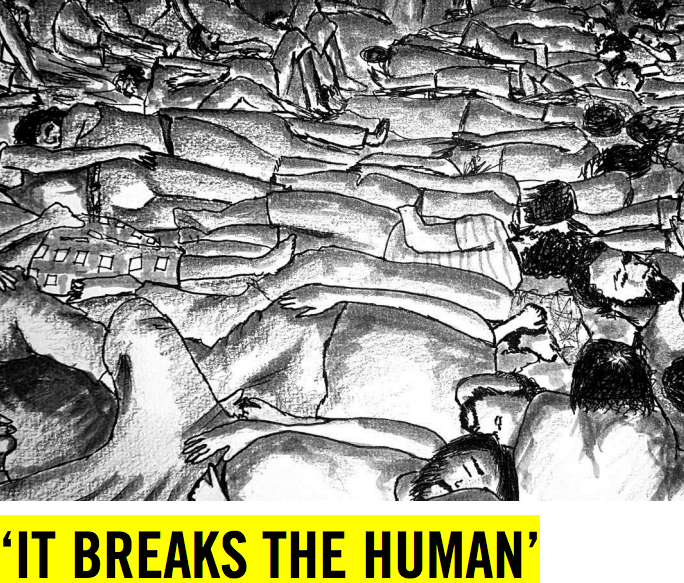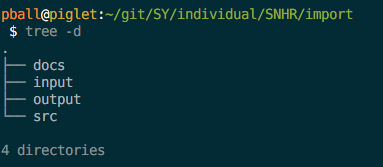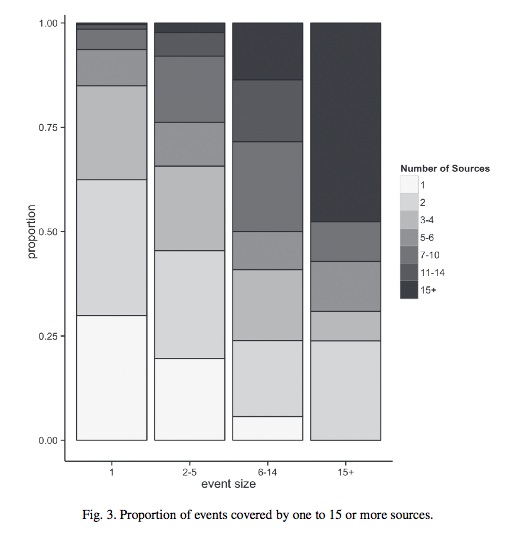Syria
blogposts describing work in Syria
HRDAG and Amnesty International: Prison Mortality in Syria
Today Amnesty International released “‘It breaks the human’: Torture, disease and death in Syria’s prisons ,” a report detailing the conditions and mortality in Syrian prisons from 2011 to 2015, including data analysis conducted by HRDAG.
The report provides harrowing accounts of ill treatment of detainees in Syrian prisons since the conflict erupted in March 2011, and publishes HRDAG’s estimate of the number of killings that occurred inside the prisons.
To accompany the report, HRDAG has released a technical memo that explains the methodology, ...
The task is a quantum of workflow
This post describes how we organize our work over ten years, twenty analysts, dozens of countries, and hundreds of projects: we start with a task. A task is a single chunk of work, a quantum of workflow. Each task is self-contained and self-documenting; I'll talk about these ideas at length below. We try to keep each task as small as possible, which makes it easy to understand what the task is doing, and how to test whether the results are correct.
In the example I'll describe here, I'm going to describe work from our Syria database matching project, which ...
Rapid response to: Civilian deaths from weapons used in the Syrian conflict
On November 4, 2015, the BMJ published our "Rapid Response" to Civilian deaths from weapons used in the Syrian conflict (BMJ 2015;351:h4736). The response was co-authored by Megan Price, Anita Gohdes, Jay Aronson (Carnegie Mellon University, Center for Human Rights Science), and Christopher McNaboe (Carter Center, Syria Conflict Mapping Project).
We have three concerns about this article. First, the article apportions responsibility for casualties to particular perpetrator organizations based on a single snapshot of territorial control that ignores the numerous (and ...
Update of Iraq and Syria Data in New Paper
This week The Statistical Journal of the IAOS published a new(ish) paper by Megan Price and Patrick Ball. The open-access paper, Selection bias and the statistical patterns of mortality in conflict, is a revisiting and updating of both the Iraq and Syria examples used in an earlier paper, Big Data, Selection Bias, and the Statistical Patterns of Mortality in Conflict, which was published last year inThe SAIS Review of International Affairs (JHU Press, 2014).
HRDAG believes that the concerns highlighted by these examples are important for a wide variety of audiences, ...
Syria: No word on four abducted activists
Razan Zatouneh is an esteemed colleague of ours, and we are one of 57 organizations demanding immediate release for her and the three other human rights defenders still missing.
A year on, no information on Douma Four
The prominent Syrian human rights defenders Razan Zaitouneh, Samira Khalil, Wa’el Hamada and Nazem Hamadi – the Douma Four—remain missing a year after their abduction, 57 organizations said today. The four were abducted in Duma, a city near Damascus under the control of armed opposition groups. They should be released immediately, the groups ...
Updated Casualty Count for Syria
Today the United Nations Office of the High Commissioner for Human Rights (OHCHR) released an HRDAG-prepared report that describes and tallies documented killings in the Syrian Arab Republic from the beginning of the conflict in March 2011 through April 2014. (The report is here.) This is our third report for the UN on the Syrian conflict, and it is an update of work we published in January 2013 and June 2013.
The report, Updated Statistical Analysis of Documentation of Killings in the Syrian Arab Republic, concludes that approximately 191,000 identifiable victims have ...
14 Questions about Counting Casualties in Syria
In early 2012, HRDAG was commissioned by the UN Office of the High Commissioner for Human Rights (OHCHR) to do an enumeration project, essentially a count of all of the reported casualties in the Syrian conflict. HRDAG has published two analyses so far, the first in January 2013, and the second in June 2013. In this post, HRDAG scientists Anita Gohdes, Megan Price, and Patrick Ball answer questions about that project.
So, how many people have been killed in the Syrian conflict?
This is a complicated question. As of our last report, in June 2013, we know that there have ...
HRDAG at Strata Conference 2014
Last Thursday, HRDAG co-founder and director of research Megan Price presented at Strata, the conference for data scientists and people who work with "big data." In her talk, she addressed the question of how we can know the actual number of conflict casualties in Syrian. Her short answer was, "We don't know." The longer answer was that we have a very good idea of how many conflict casualties have been reported, by several documentation groups, and that we're working on analyzing (more…)
Seeking the Truth with Documentation
The need to establish the truth around events is central to goals of transitional justice, particularly securing accountability, establishing legitimate and effective justice mechanisms, and laying the foundations for a peaceful society.
Documentation to provide verifiable and widely accepted accounts of such events is a critical component of establishing this truth, or the multiple truths that may exist for a population. It is difficult to overstate the important role of documentation in transitional justice efforts. If some of what follows sounds familiar, echoing ...
Counting Casualties in Syria
Today the United Nations Office of the High Commissioner for Human Rights (OHCHR) released a report prepared by me and my colleagues describing the current state of reported killings in the Syrian Arab Republic from the beginning of the conflict in March 2011 through April 2013. (UN news release here.) This report is an update of work we published in January 2013. This updated analysis includes records from eight data sources documenting a total of 92,901 reported killings.
Our analysis begins with 263,055 total records reported by the eight data sources that ...
How we go about estimating casualties in Syria—Part 1
I spent the two weeks over Easter working with Patrick and Megan in San Francisco, trying to figure out a strategy of how best to estimate the number of casualties the Syrian civil war has claimed in the past two years. In January, HRDAG published a report on the number of fully identified casualties reported in the Syrian Arab Republic between March 2011 and November 2012. The number of de-duplicated records of killings for this period was 59,648, a number that is likely to be an undercount since we know that many incidences of lethal violence in conflict go unreported, ...
Transitional Justice in Syria: Accountability and Reconciliation Conference
I spent last weekend in Istanbul at an excellent conference organized by the Syrian Center for Political and Strategic Studies (SCPSS). The conference included numerous non-governmental organizations (NGOs) from Syria as well as international human rights researchers and advocates. Families of victims told their stories, data collection groups discussed the challenges, and need, to document violations, transitional justice experts worried about infrastructure such as the police force and judicial system, and local leaders pledged to work together for peace.
I was ...




